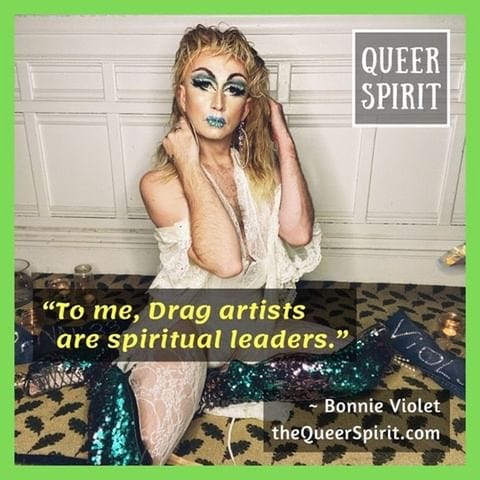Drag has a long history of helping marginalized people find community and acceptance. There’s a reason why queer folks often say that a particular performance “took them to church.” Drag is celebratory, joyful, and healing.
For some, there’s a more direct connection between drag, burlesque, and spirituality — one that has helped performers embrace their calling as spiritual leaders and as beloveds of the Divine.
Amichai Lau-Lavie grew up conflicted between his place in a long lineage of rabbis and a belief that, because he was gay, per the Torah, he was an abomination. This conflict led him to leave the conservative Jewish tradition he grew up in for a long time.
But there was one place where the queer tradition of performing gender and Jewish rituals overlapped: Purim. During an interview with Krista Tippett for On Being, Lau-Lavie described Purim as a “Jewish sort of Carnival,”
When he was four, he started dressing up like a girl during Purim. It was the one time of the year when this drag-like performance was accepted in his community. “And the older I got, I was interested in what Purim has to offer us as grownups in this masking and unmasking,” he explained on the podcast. “And also, politically, Purim is a very interesting and complicated conversation about racism and about the ethnic and the “other” within us.”
One Purim in the late 1990s, he came up with a character, Hadassah Gross, who was a Hungarian widow of a rabbi and a Kabbalah teacher. This was long before he’d decided to embrace the call to follow in his father’s footsteps and become a rabbi himself. As Tippett pointed out, “you weren’t going to be a rabbi, but you could be a rabbi’s wife.”
I was in New York. I was hanging out with the Radical Faeries and other interesting queer spiritual groups where drag was sort of OK in many ways of fluidity, in between spirituality and joking and ritual and shows. And that in-between — it’s not serious; it’s not play; it’s not drag; it’s not not — it’s where lighting candles became a very sacred place.
-Lau-Lavie from his On Being interview
Lau-Lavie explained that Hadassah “served an important role in [his] own coming to terms with being out.” And, as Tippett hinted, the persona probably also helped Lau-Lavie embrace his role as a spiritual teacher and leader, as well.
Around 2015, a longtime AIDs activist took to the stage in San Francisco as Bonnie Violet, and discovered she had a different relationship with her drag persona than the other performers.
“They were always talking about how, at the end of the night, they couldn't wait to get out of the drag,” she told me during an interview for Left-Handed Journeys, “and I never wanted to get out.”
While doing drag helped her to embrace her transness, it also helped her better understand God. “I've just been able to, with the help of God, excavate my spirit and put it on my outside and share it with people,” Bonnie Violet told me.
So I say that my transness is a spiritual experience. If I wasn't seeking God, or some sort of spiritual connection, I wouldn't be able to call myself Bonnie Violet. And I wouldn't be asking you to do the same.
— Bonnie Violet from our Left-Handed Journeys interview
Part of the power behind drag is the ability to play with aspects of yourself that have been deemed bad or sinful, like femininity, eroticism, or being loud and taking up space. Working with these taboos in character can feel safer. You get to try things out and see what you want to own for yourself. What you want to redeem. For some, this is their transness, their bad-assness. For others, it’s their connection to the Divine or their belief that they are — and have always been — beloved.
Similar to Lau-Lavie, Bonnie Violet grew up in a conservative tradition which led her to believe that she wasn’t capable of a relationship with God because she was gay. And drag was one of the things that disproved this: “It seems like I constantly get people to say, there's no God in you. I'm like, actually I am a direct result of God being of me, of me knowing that God is in me.”
Bonnie Violet now works as an identity doula, helping people find spiritual threads in their narratives and embrace who they are becoming. She also explores the connection between drag and spirituality in her Drag and Spirituality interview series and her first annual Drag and Spirituality Summit.
Meanwhile, Lau-Lavie went on to found Storahtelling, Inc, a storytelling group offering new interpretations of the Jewish identity, and Lab/Shul, a pop-up synagogue in New York City that is “everybody-friendly, artist-driven, God-optional.” In 2016, he completed his rabbinical training.
I hope you enjoyed this innaugural post of Radical Soul. If you did, I hope you’ll subscribe and/or share the love.






She is not wrong. Queens and other drag performers hold valuable space in the queer community--particularly among the most overlooked. And many of them intentionally dwell in the realm of the spiritual, often simply because of who they are.
Thank you for sharing my story in this inaugural post!! xoxo Looking forward to reading more. xoxo